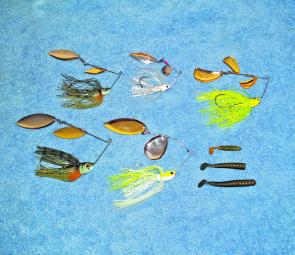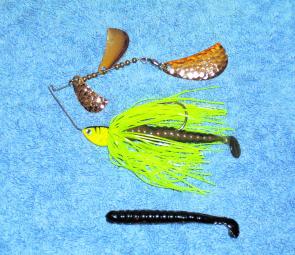We should always remember that recruitment of new anglers is important to the longevity of our pastime. Keeping it simple and easy-peasy is the best way for newcomers to start out. And what better way to begin than with the casting spinnerbaits along the banks.
I wished that Aussies had discovered and embraced spinnerbaits before I was a kid. Back then I was so keen on casting crankbaits to bass in the creeks, but every time one of my trebled crankbaits hung up on an underwater snag or piece of weed, I had to go for a wade or swim in order to change the angle of the line and get the lure back.
It was always so stressful to get your lure snagged. Then along came the lightweight tackle (for bankside anglers) and there was less need to get wet. Today I wouldn’t even bother packing a bibbed crankbait (well, maybe just one). For a walk along a creek bank for bass and sooties I’d pack three types of lures: spinnerbaits, topwaters and bibless minnows.
In this edition of back to basics I’ll look deeper into the use of spinnerbaits. But first, let’s look at the outfit.
One thing that has improved for kids, and bank walkers, is the cost of a light tackle outfit; a good baitcaster outfit used to cost the earth! These days there is little difference between the quality of well-priced entry level rods; many of them have copied each other, and these pretty much copied the best rods of years ago.
For your choice of reels, just keep in mind that some brands will be more corrosion resistant and able to withstand Australia’s coastal environs better than those made for the world’s freshwater markets. I have Penns, Diawas and Shimanos that have lasted many years.
My choice of line is generally braid of 4kg breaking strain or less, and I run about a 5-6kg abrasion resistant leader. I go up in leader strength if the environs are snaggy, and go down in diameter if the water is super clear.
Spinnerbait lures are best fished from a light spin outfit using a 1000-2000 sized spin reel and a graphite spin rod between 1.5-2.1m. The length of the rod is normally governed by the angler’s height and the amount of bankside vegetation that they have to negotiate when flicking out a cast (I’ll cover the bow and arrow, door handle rotation and pitch casts in future editions of this back to basics series).
Likewise, the size (width) of the waterway will also influence your rod choice. The wider the river, the further you’ll want to cast – until you hook up all the way over there and have to fight the fish back past every piece of sunken timber! Anyway, picking a rod closer to 2.1m than 1.5m will, all things being equal, offer you the potential of longer casts and easier steerage of the fish.
There are many spinnerbait options on the tackle shop wall.
I like hooks to be around 1/0 size with the arm adorned by a double willow blade configuration for bass and sooties. One of my favourite blade variations is the triple chopper Gambler Blades. My main choice of colour is white with a flash of silver; I will carry a few other colours just for variation. Silver and gold blades each seem to have their day so a mix of options gives you a change-up. Whatever you do, keep it simple. The lighter that your tackle box weighs, the better.
For larger fish such as saratoga and Murray cod I use spinnerbaits with 3/0 hooks and larger.
Spinnerbaits are the bomb because they are so snagless. You can literally run them into and up and down submerged timber and they’ll seldom hang up. Just a straight steady retrieve with the rod tip held at 45º is often all that is required to solicit a strike. You can also burn the spinnerbait just below the surface with a faster retrieve. However creek bass are seldom that aggressive, but you’ll find out if there are any tarpon hanging around.
By far the best retrieves are:
• To work the edges of weed, where the bass lay in wait to ambush any likely pieces of food; or
• To bump into every piece of timber in the water and let your lure blades flutter in freefall for a few seconds after making contact with the timber. Drop your rod tip by about a metre immediately after you’ve rubbed your lure on the submerged snag. The bass or sooty will be doing its ambush trick again and will engulf your lure on the drop.
If you aren’t getting any bites, try slowing your retrieve. Just be mindful that your lure will sink deeper, which might not be ideal if there is a lot of weed on the bottom. To compensate this either use a smaller, lighter spinnerbait, which can rob you of casting distance, or spice the single hook of the spinnerbait with a floating grub like a Slider 1.5” or 3” Slider. A third, more complicated variation is to swap out the lower willow blade for a rounder ‘Colorado’ blade. Colorado blades give more lift to the lure when retrieved through the water.
I seldom use stinger hooks on my spinnerbaits when walking the bank. My philosophy is that you are out there for a walk and a good time and I like to reduce the risk of snagging (especially tangling in weed). I also like to fish barbless hooks to reduce the risk to my fingers. Actually I’ve stuck trebles in most parts of my body over the years; toes, legs, fingers, hands and even my butt. Fishing barbless also makes it easier to release the fish.
On my frequent return visits to Queensland, I always like to spend an afternoon getting back to basics, keeping it simple, remembering where it all started. Why not find a newbie or two and show them the ropes?
Regulations
A closed season applies to Australian bass throughout Queensland from 1 June to 31 August except in and from waterways upstream of Baroon Pocket, Bjelke-Petersen, Boondooma, Borumba, Cania, Cressbrook, Fred Haigh (Lake Monduran), Gordonbrook, Hinze, Lenthalls, Maroon, Moogerah, North Pine, Somerset, Wuruma and Wivenhoe dams; Claude Wharton and Jones weirs; Isis Balancing Storage (Lake Gregory), and Dyer (Bill Gunn Dam) and MacDonald lakes.
Where to fish
Sadly, a lot of the bank side bass fishing spots that I used to frequent as a kid in South East Queensland are now no go zones. Nevertheless, if you want to have a bass fish then river crossing bridges and culverts, areas well below dam walls (check regulations as just about every outflow will have a no fishing zone), creeks upstream of stocked impoundments and creeks running through private property farms are some of your better options.
Reads: 4450
Andrew Moriarty with a spinnerbait caught sooty grunter. The rapids/whitewater in the background is a hotspot giveaway; the inflowing water at the heads of pools are a great place to fish.

A selection of spinnerbaits, from the smaller size (middle top) for sooties and creek bass, to larger ones for cod. Crush the barbs down and you are ready to go bankside wandering. The triple blade Gambler is top right, the double willow is bottom right,

Adding a 1.5” or 3” Slider (or alternatively a shortened 3” Slider) to the hook of your spinnerbait will give it buoyancy in the water, enabling a slower retrieve without robbing you of casting distance.

The timber in the water is a perfect ambush site for predatory fish. Using hardbodies you’ll tentatively probe around them; with spinnerbaits you can confidently bump the stump.




